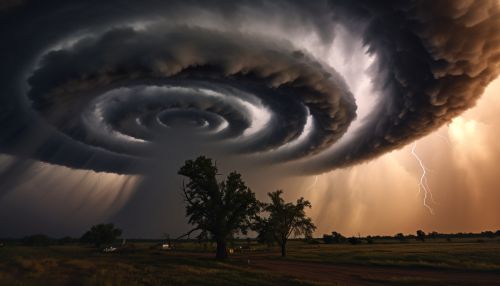Multiple vortex tornado
Introduction
A multiple vortex tornado is a type of tornado that contains several vortices, or smaller tornadoes, revolving around a common center. These smaller vortices often produce damage paths of their own, separate from the main tornado. This phenomenon is distinct from a satellite tornado, which is a weaker tornado that forms very near a large, strong tornado contained within the same mesocyclone.
Formation
Multiple vortex tornadoes can form in a variety of ways. They can be the result of a single, large tornado that breaks up into multiple smaller tornadoes, or they can form independently from a single parent thunderstorm. The exact mechanisms that lead to the formation of multiple vortex tornadoes are not fully understood, but it is thought that variations in wind speed and direction, as well as changes in atmospheric pressure and temperature, can contribute to their formation.


Characteristics
Multiple vortex tornadoes are characterized by the presence of multiple smaller tornadoes, or subvortices, rotating around a common center. These subvortices can be of varying sizes and intensities, and they can rotate at different speeds and in different directions. The subvortices can also move independently of the main tornado, resulting in a complex and often unpredictable damage pattern.
Damage and Impact
The damage caused by multiple vortex tornadoes can be extensive and severe. The presence of multiple vortices can lead to a wider damage path than would be caused by a single tornado, and the varying intensities and directions of the subvortices can result in a highly variable damage pattern. Structures can be completely destroyed in one area, while nearby areas are left relatively unscathed.
Detection and Forecasting
Detecting and forecasting multiple vortex tornadoes can be challenging. Traditional radar systems may not be able to accurately detect the presence of multiple vortices, particularly if they are small or close together. Advanced radar systems, such as Doppler radar, can provide more detailed information about the structure of a tornado and can help to identify the presence of multiple vortices. However, even with advanced technology, predicting the formation and behavior of multiple vortex tornadoes remains a significant challenge.
Research and Studies
Research into multiple vortex tornadoes is ongoing, with scientists seeking to better understand the conditions that lead to their formation and the mechanisms that drive their behavior. This research is crucial for improving our ability to predict and respond to these dangerous storms.
